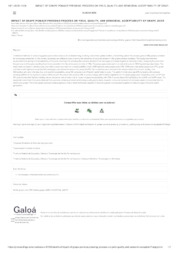Impact of grape pomace pressing process on yield, quality, and sensorial acceptability of grape juice.
Impact of grape pomace pressing process on yield, quality, and sensorial acceptability of grape juice.
Author(s): BIASOTO, A. C. T.; DUTRA, M. DA C. P.; AMORIM, T. A.; ARAÚJO, A. J. DE B.
Summary: Traditional methods for producing grape juice involve steps such as destemming, crushing, maceration, pasteurization, and bottling, where the process yield (<70%) poses a problem for producing companies. In this context, pressing is an additional step, involving the extraction of juice still present in the grape pomace (residue). This study examined the physicochemical quality and acceptability of the juice resulting from pressing the pomace obtained from two types of presses (hydraulic and pneumatic), analyzing the juice from the pomace and the juice resulting from its incorporation into the whole juice (at ratio of 13%). The juices were produced on an industrial scale in 3000 kg stainless steel tanks. The treatments consisted in: whole grape juice without juice resulting from pressing addition (WJ), 100% hydraulic press grape juice (HP), 100% pneumatic press grape juice (PP), grape juice blend with hydraulic press (WJHP), and grape juice blend with pneumatic press (WJPP). The treatments were evaluated for soluble solids (SS) content, acidity, ratio (SS/acidity), pH, color intensity, hue, and overall acceptability using 100 consumers and 9-point hybrid hedonic scale. The yield of whole juice was 67% increasing with pomace pressing addition in the hydraulic press to 87% and with the pneumatic press to 93%. All juices comply with Brazilian legislation for the whole grape juice. Regarding color, the PP and HP juices showed the highest intensity values. Consumer test showed that all juices had good acceptability, with 70% of scores above 5.5, highlighting WJ, WJHP, and WJPP juices. The results demonstrated that juices obtained from pomace pressing achieved satisfactory quality parameters; however, consumer acceptance increased when incorporated into the whole juice grape. Therefore, grape pomace pressing appears to be a viable technique capable of improving grape juice processing yield and reducing agro-industrial waste generation.
Publication year: 2023
Types of publication: Abstract in annals or event proceedings
Unit: Embrapa Environment
Observation
Some of Embrapa's publications are published as ePub files. To read them, use or download one of the following free software options to your computer or mobile device. Android: Google Play Books; IOS: iBooks; Windows and Linux: Calibre.
Access other publications
Access the Agricultural Research Database (BDPA) to consult Embrapa's full library collection and records.
Visit Embrapa Bookstore to purchase books and other publications sold by Embrapa.

